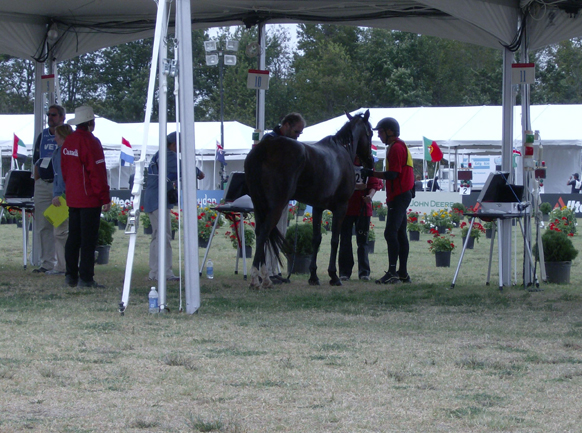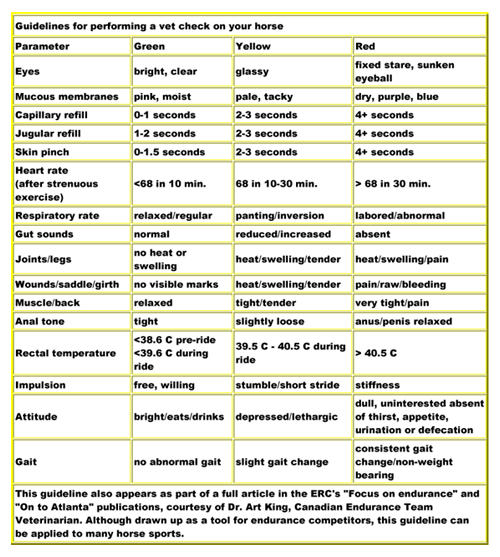The Vet Check
The Vet Check
Dr. Art King
A Systematic Method of Examination
The vet check is a critical factor with endurance competition. However, it is very useful in day-to-day management as well. Every horse person should learn how to check a horse's physical condition for any telltale signs of illness, injury, or fatigue. Many potentially serious conditions can be picked up at an early stage by this simple series of tests. No sophisticated equipment or tests are required. A stethoscope, a watch capable of indicating seconds and a thermometer (preferably with a clip attached) is all the equipment one needs along with a basic understanding of the difference between what is normal and abnormal for the various areas of the horse that can be examined. With a little practice, one can examine the horse in less than five minutes using a systematic method of examination.
A complete examination involves two parts: an examination of the horse at rest and in motion.
The horse at rest
Choose an open area such as a large box stall or wide alleyway. If the horse is quiet, it can be tied or have an assistant hold the horse for you. Once the horse has been adequately restrained in a safe and suitable location, the examiner should approach the horse's head from the front and to the left of the horse. First of all, note the horse's general condition and attitude. Is the horse over or underweight? You should be able to feel the ribs when you run your fingers across, the the rigs should not be obvious. Is the haircoat sleek or dull? Is the horse alert or lethargic? Since a temperature reading with a conventional mercury bulb thermometer takes about one minute, time can be saved if the thermometer is placed into the rectum and restrained there with the clip attached to the tail while continuing with the examination.
Head and neck area
Starting at the horse's head, lift the upper lip and note the colour of the gums. Normally, this mucous membrane surface is a healthy pink colour and slippery to the touch. A tacky or dry surface can indicate dehydration. Colors such as pale white, jaundiced, brick-red, blush or purplish, or muddy are indicative of a problem and warrant further investigation. The capillary refill time is tested by blanching an area of mucous membrane above the teeth with the thumb, releasing the pressure, and counting the seconds that elapse while the colour returns to the blanched area. Normal time is up to 1.5 seconds. Delays of two to three seconds are cause for concern. Delays beyond four seconds are serious and exercise should not continue. Delayed capillary refill time is an indication of reduced blood circulation due to reduce volume (blood loss or dehydration) and/or decreased blood pressure (shock).
Next, check the nostrils for discharge. Normally there is no discharge, or a slight watery, clear discharge may be present. Any bloody, purulent, yellowish, creamy-white or greenish coloured discharge is abnormal and should be investigate. Check the bit and bridle areas for sores (check inside the mouth as well).
The jugular refill time, like the capillary refill time, is an indicator of the status of the circulatory system. This is checked by running the thumb or forefingers down the jugular groove with enough pressure to squeeze the blood from the vein. Digital pressure is then maintained over the vein while it refills. The refilling is seen as the collapsed vein becomes distended as it refills. A refill time of up to one to two seconds is normal. As with capillary refill time, a delay beyond four to five seconds is cause for limiting further exercise.
While dehydration leads to changes in a number of the areas that are examined (i.e. capillary and jugular refill, gut activity, attitude, and impulsion), the most common means to quickly check hydration is the skin pinch test. As the animal becomes dehydrated, the skin elasticity decreases due to loss of water from the skin. Take a fold of skin between the thumb and forefinger, lift it away from the underlying tissues, twist slightly and release. This procedure should be done with a light touch, without causing pain to the horse. The skin will normally snap back into place almost immediately. A skin fold or "tent" that remains for over two seconds indicates dehydration of about 3%. A delay of five seconds is serious as it indicates that dehydration may be approaching 10%. Skin elasticity is affected by a number of factors such as age of the horse and location of the skin on the body. For this reason it is important to test the same area of skin each time to maintain consistency of results for comparison purposes. The skin at the point of the shoulder is the most commonly used at endurance events, but the neck and eyelids can also be used.
The heart rate
The heart rate is determined by counting the number of beats over a short period of time and multiplying by a factor required to get a beats per minute reading. Usually the count is for 15 seconds and the number multiplied by four. The heart rate should be regular, however, dropped or skipped beats are common in well-conditioned horses at rest. The heart beat is heard as a lubb-dub, lubb-dub, ..., each lubb-dub being one heart beat. Heart rates vary widely depending upon the horse's physical condition and mental state at the time of the examination. Rates of 25 to 40 beats per minute are normal in resting horses. A fit horse should recover to a heart rate of 64 to 68 beats per minute within 10 minutes of the end of heavy exercise. Higher rates may indicate overwork, pending exhaustion, hyperthermia, pain, illness, or excitement.
Gut sounds
Gut sounds are evaluated with the stereoscope by listening over the upper and lower flank on both left and right sides. Normal gut sounds are heard as bubbling and gurgling or like the sound of waves rolling gently against a shore. The horse person should practice listening to normal horses to get an understanding of the normal gut sounds. Abnormal sounds such as pinging, ringing, or echoes of water dripping into a well would be causes for concern. The sounds can vary not only in quality and character but also in frequency. The absence of gut sounds is very serious and usually warrants treatment if no improvement is noted within 30 minutes.
Respiratory rate
Step back and note the character, quality and rate of respiration. The rate and depth of respiration can vary widely among horses. Normally, the respiratory to heart rate ratio is one to four at rest (about 8 to 12 breaths per minute), but a number of factors can alter this ratio. The rate and/or depth of respiration are not as important as other characteristics such as presence of heaves, laboured inspiration or expiration, wheezing, grunting or groaning sounds. Panting is a means that the horse can use to help cool itself. The presence of panting is usually an indicator that the horse is hot and many horses may even pant at rest on a hot and humid day. Because so many factors affect the respiratory rate at any one time, it is not possible to correlate respiratory rate and depth to physical fitness.
Checking the body
The withers, shoulders, back, croup/rump and girth areas should be palpated for evidence of sores, pain, bumps and tight musculature. This examination is often subjective. The degree of pain that may be elicited will depend upon the examiner's technique. The aim of the examiner is to detect any pain, sensitivity, or tightness that would impair the horse's athletic ability or cause pain and suffering during exercise. The left foreleg is palpated for pain, swelling, heat, etc. especially in the joints, ligaments and tendons, and splint area. Lift the foot and check the condition, type and general fit of the show. Note any cracks, founder lines, etc., that may be evident on the hoof. Repeat this examination on the left hindlimb and then go to the right fore and right hindlimb.
Checking the temperature
Remove the thermometer, note the temperature, and check the tail and anal tone. The anus should constrict immediately in response to slight digital pressure. The tail should clamp in reflex when first touched. A flaccid tail and loose anus are found in exhausted horses as well as in some nervous system diseases such as rabies.

The Examination for Soundness
The examination in motion is done with the assistance of the handler who will trot the horse first in a straight line for about 40 meters (125 feet) away from and then toward the examiner. Next, trot the horse in either a clockwise or counter-clockwise circle of about 6 to 10 meters (10 to 30 feet) in diameter, or if space permits, in a figure eight pattern. The footing in the trotting area should be level, even and reasonably firm. Avoid slippery or uneven surfaces as this makes it difficult to properly assess the horse in motion. In some instances it may be beneficial to examine the animal's trot on both a hard surface, such as a paved or hard-packed roadway, and a soft surface of sand or loose soil.
The handler should trot the horse on a loose rein at a steady slow trot, taking care to travel to the left of the horse, rather than in front of the horse. This ensures that the examiner's view is not obstructed. Do not hold the horse with a short lead as this exaggerates or restricts normal head motion. The horse should then be trotted in circles or the figure eight at a steady trot. The examiner is looking for evidence of lameness, gait abnormalities and quality of movement. Note any of the following motions: hiking, head bobbing or swaying, hopping, winging or paddling, base-wide or base-narrow motion, as well as head, back and tail carriage. Stride length and height, as it relates to quality of gait and impulsion, should also be noted. Listen for any unevenness of hoof beats on the ground.
Cardiac Recovery Index
The cardiac recovery index is a useful indicator of a horse's condition, especially if it is used at rest stops during a competition or during recovery following exercise. The examiner takes the horse's heart rate immediately prior to trotting the horse a distance of 125 feet away and then back to the examiner. The heart rate is taken one minute following the START of the trot. The two heart rates are compared and should be within a few beats of each other. If the post-trot reading is eight or more beats/minute higher than the pre-trot reading, the horse should be carefully evaluated. Assuming that excitement did not cause the higher reading, one should consider injury, fatigue, dehydration or other causes that may be the underlying cause of the elevated reading. While the horse is trotting out and back for the cardiac recovery index, the attitude, impulsion and quality of gait can be observed at the same time.
Summary
Throughout the entire examination, the examiner is looking for evidence of cuts, wounds, and skin lesions as well as noting from observation and by questioning the handler the horse's appetite, level of thirst, defecation and urination. Following this systematic procedure, the examiner has quickly evaluated the horse's major systems. He or she should have a general impression of whether the horse is in need of further medical attention for determining the cause and treatment of any problems that may have been identified.

The contents are copyrighted but may be copied,
on condition that the Equine Research Centre be
acknowledged for the use of its information.

- Log in to post comments
